 |
|

|
 |
TABLE of CONTENTS
|
Future workforce members survey Construction Career Day |
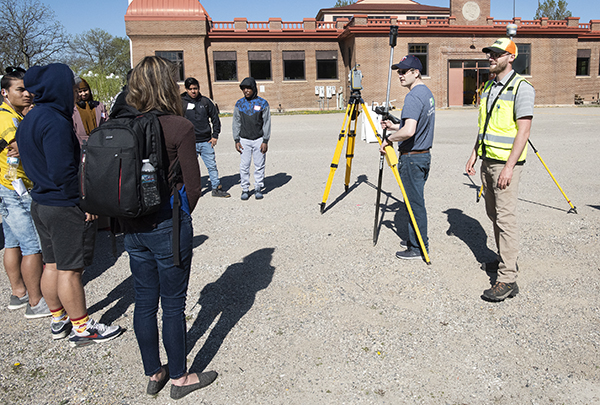
Michael Nelson (center) and Brandon Boatman-Nelson (right), Oakdale survey office, show students how to use technology to measure distances and height, and find coordinates during the first Construction Career Day at the state fairgrounds in St. Paul last week. About 125 Twin Cities area students attended the event, which was designed to help introduce students to career opportunities in construction and transportation. Photo by RIch Kemp |
|
 |
|

|
 |
TABLE of CONTENTS
 |
Looking back at winter that was |
By Anne Meyer
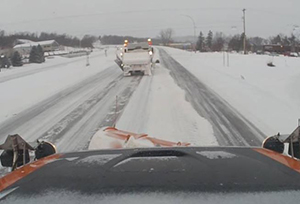
This 511.org screen capture shows a team plow operation in January. Maintenance staff recently met in St. Cloud to review snow removal efforts from the past season. MnDOT file photo |
Warmer weather has arrived in Minnesota, but winter is still fresh in the minds of MnDOT maintenance crews.
District maintenance supervisors, superintendents and engineers gathered earlier this month at the annual winter wrap-up meeting in St. Cloud to talk about snow removal efforts.
The Maintenance Decision Support System was a key topic for this year’s meeting. Each snowplow is equipped with the MDSS system to help drivers during events by recommending treatments based on real-time weather and road conditions. Representatives from Iteris, the company that developed MDSS, were also at the wrap-up meeting. Information gathered there will be used to improve the system.
“Finding ways to reduce the amounts of chlorides, without impacting traveler safety and mobility, requires all of us to look deeply at the tools we use during snow and ice operations,” said Jed Falgren, District 7 maintenance engineer. “Coming out of a challenging winter, it is very helpful to get everyone in the same room to share experiences about what worked and what can be improved, and to start looking ahead to the next season.”
Liquid application was another main topic for the day. District 1 shared information on its expanded use of potassium acetate on several routes, which is part of a research project. Final results of the project are still pending. Other districts described the use of salt brine and alternative chemicals, such as Beet Heet and APEX-C. The team also talked about tactics for anti-icing, deicing, slurry systems, brine production and storage. Crews say liquid applications kept more material on roadways, helped break up compaction and reduced salt use. Due to that success, crews should expect to see more liquid applications used across the state next winter.
Numbers from the 2018-19 winter season about snowfall, salt and sand usage, and costs are still being finalized. The Winter Maintenance At A Glance Report should be complete in late June.
|
 |
|

|
 |
TABLE of CONTENTS
 |
Project plants new roots at Victory Drive, Hwy 22 |
|
By Joseph Palmersheim
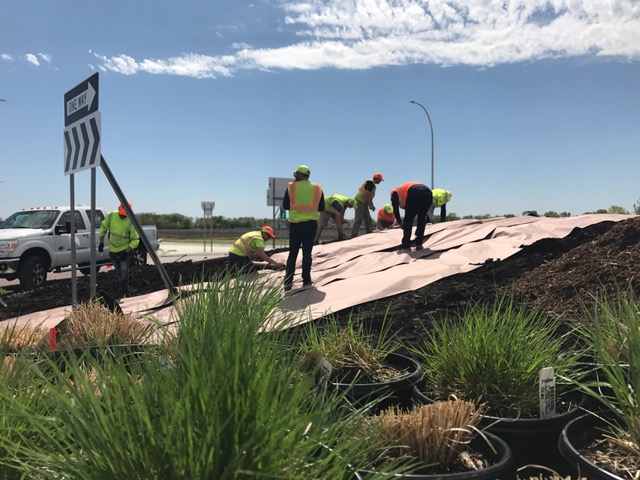
Contractors planted greenery at the new roundabout at the intersection of Hwy 22 and CR 90 the week of May 13. Photo by Rebecca Arndt |
When World War Two ended in 1945, the Mankato Garden Club collected donations to plant trees among the Victory Drive corridor. For $1.50, residents could purchase a planting in honor of the soldiers who served in both world wars. More than 1,400 were planted, and in time, they grew deep roots – not only as plants, but as a local landmark, the Victory Drive Memorial Corridor.
Plans to improve and beautify Hwy 22 from Mapleton to north of Blue Earth County Road 90 took into consideration the area’s history and meaning. Since 2017, Hwy 22 has been reconstructed from Mapleton to Blue Earth County Road 15, and a roundabout was added at the intersection of Hwy 22 and CR 90. Plantings for the new roundabout were underway the week of May 13.
“This is really going to mean a lot to the community,” said Robert Jones, project manager and senior engineer. “This was a sensitive issue. We had so much public involvement and engagement, and the transparency was tremendous. I think the community understood – ‘They’re trying to do it right for us.’”
Nearly 700 trees in the corridor had to be removed either to poor health or being too close to clear zones. More than 400 are being replanted. The trees aren’t the only plants involved. The improved drive will have five unique planting patterns, representing the five branches of the U.S. military.
Jones said a celebration will take place in summer or fall, once new monuments (a non-MnDOT project funded by donations to the Mapleton Area Foundation) are in place.
“When all of this is done, I’ll look back with a smile as I ride through it on a motorcycle,” said Jones, who is a military veteran. “I’ll be very proud of what we accomplished here.”
Project website
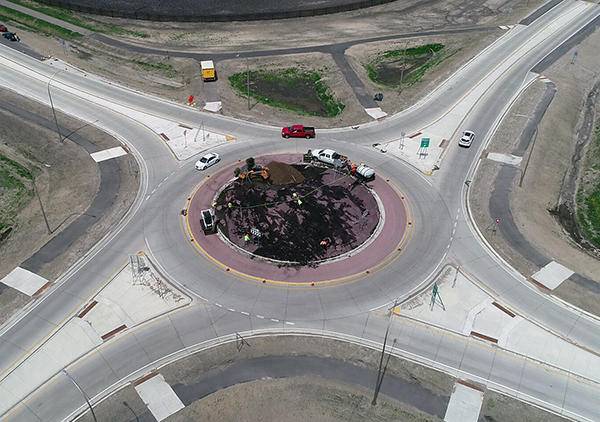
This overhead drone shot captures the layout of the new roundabout at the intersection of Hwy 22 and CR 90. Photo by Robert Jones |
|
 |
|

|
 |
TABLE of CONTENTS
 |
Blowing snow control added to Shared Services portfolio |
|
By Joseph Palmersheim
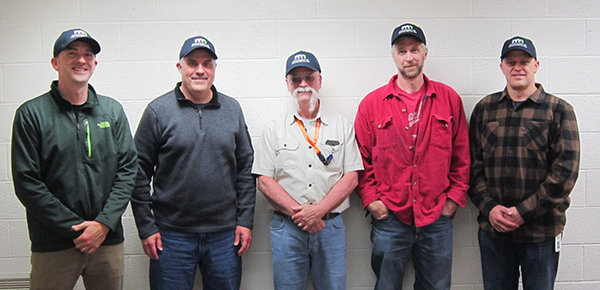
MnDOT's Blowing Snow Control Shared Service team, from left: Trent Robbins, Dan Gullickson, Dennis Moline, Steve Dols and David Keranen. Photo courtesy of Dan Gullickson |
Did you know wind can move snow more than two miles from where it fell?
Blowing snow control was recently added to MnDOT’s portfolio of Shared Services in the Operations Division. This realignment will provide help to district project managers and maintenance supervisors in addressing blowing snow issues. Snow control barrier options include plantings (like trees and shrubs), grading or structural snow fences. Many of these barriers are on private land, requiring the cooperation of landowners.
Under the new Shared Services model, four designers can assist districts with designing blowing snow control measures. Three engineering specialists (located in Detroit Lakes, Willmar and Mankato) will be able to develop blowing snow control plans that can be constructed in partnership with private landowners. The placement of these three positions is deliberate, said Dan Gullickson, who supervises MnDOT's Blowing Snow Control Shared Services Program.
“Seventy percent of the snow in these three regions gets relocated by the wind,” he said. “Those are Siberia-like conditions. We have these three positions following that contour.”
In addition, one senior designer and Gullickson will be located at Central Office.
This Shared Service can be requested by completing the Blowing Snow Control Shared Service Request Form. It is eligible for State Road Construction funding and is paid for by the requesting district. Stand-alone maintenance projects may also use this service.
While Blowing Snow Control Services address issues in the present, these efforts are sometimes helped by information gathered in the past. A University of Minnesota-developed winter climate database tracks weather data going back to the state’s earliest days. This allows MnDOT to estimate the tons of snow that affect the roads in a given area each season. With that knowledge, designers can determine snow barrier height and how far they need to be set back from the road.
Of course, identifying a solution first involves defining a problem. Needing extra plow services is a leading indicator, and crash numbers are another. Knowing where the problem area starts and ends allows the blowing snow control designers to examine the capacity of the nearby ditches to hold snow. “Fetch distance,” the ability for wind to move snow in a given area, is also checked.
Since 2002, MnDOT plow drivers have used GPS to map more than 3,700 problem sites (about 1,200 miles) needing extra plowing, blowing or salt services.
“If we can prevent the snow from hitting the road, we can reduce some of our salt impacts,” Gullickson said. “It also helps us reduce our fuel use. Those are two things that are important for sustainability within the organization.”
The results can be dramatic. Crashes near Moorhead totaled 27 during the winter of 2017-2018 and were reduced to four this past winter due to the use of snow fencing. This video from District 4 depicts the impact of blowing snow control measures.
While the fruits of snow control labor are most obvious during the winter, design work is year-round. Much of the landowner engagement occurs during summer and winter months. Planting living snow fences takes place before the snow falls, but crews can construct structural snow fences at any time, including in the dead of winter.
According to Marilyn Jordahl Larson, Shared Services Program director, districts have indicated “strong support” of this Shared Service, expressing interest in studying more than 500 problem sites in the near future.
“We aren’t going to solve all of these in a year,” Gullickson said. “This is going to be something that we take the long-term corridor approach to addressing.”
More information about blowing snow control may be found at ihub/sharedservices, or by contacting Gullickson at daniel.gullickson@state.mn.us or Jordahl Larson at marilyn.jordahl@state.mn.us. |
 |
|

|
 |
TABLE of CONTENTS
 |
Human Resources launches new employee referral program |
By Mary McFarland Brooks
MnDOT’s new statewide Human Resources referral program launched May 14. This program encourages employees to introduce talented friends, family members and former colleagues to career opportunities at MnDOT.
“Currently, 38 percent of selected candidates are referred by our employees,” said Mary Stohr, assistant staffing manager in the Office of Human Resources. “Our MnDOT employees play an important role in contributing to the hiring of new team members and the overall growth of the agency.”
MnDOT recruitment specialists Lena Garcia and Mao Lowe staffed an information table by the Central Office cafeteria during the launch . An email to all MnDOT employees statewide explained the year-long program. Meetings in each district will cover the referral program.
Who can make a referral?
- Any MnDOT employee not involved in the hiring/selection process may refer a candidate.
- MnDOT Human Resources reserves the right to evaluate program eligibility on a case-by-case basis.
Who can be referred?
Candidates are eligible for referral if:
- They are not a current state of Minnesota employee (i.e., temporary, intermittent or student worker).
AND
- They have not been referred previously by someone else for the same position.
What are the benefits for referred candidate?
- Once the referral is received, a MnDOT recruiter will reach out directly to the referred candidate(s) to identify their skill sets/skill level, identify positions of interests within MnDOT, and provide assistance with resumes and navigating the application process.
How to refer someone?
- Before the application deadline, email jobs.dot@state.mn.us with the subject line “Employee Referral.” Include the candidate’s name and the Job ID number they are applying to.
If the referred candidate is hired, the employee who referred tem will receive a voucher to redeem for MnDOT merchandise, such as caps, portfolios, coffee mugs, journals, pen and key sets, and beanie hats.
For more details about the employee referral program, email jobs.dot@state.mn.us, or visit the MnDOT careers webpage and the state of Minnesota Career website.
|
 |
|

|
 |
TABLE of CONTENTS
 |
Catherine Barrie-Medellin is eligible for vacation donation |
Catherine “Cate” Barrie-Medellin, transportation generalist senior with the Office of Materials and Road Research, is eligible for the vacation donation program.
Pregnant with tins, Barrie Medellin was hospitalized on complete bedrest when she went into labor March 31, and her twins were delivered via C-section. During the procedure, the doctors also removed her appendix because there were visible tumors on it. Her doctors confirmed that Cate has a life-threatening disease. Cate is seeing a specialist from the University of Minnesota and undergoing treatment there.
Barrie Medellin has used all of her accrued leave time on her hospitalization before the twins’ birth, as well as recovering from multiple surgeries, numerous doctor appointments and tests.
Also eligible for the vacation donation program are MnDOT employeesAnne Caron, Office of Materials & Road Research; Donna Koren, Operations Division; Bruce Madson, transportation generalist in District 6; Tom Brown, transportation generalist in District 2; Donald Obernolte, Office of Environmental Stewardship; Kyle Goosman, District 8 transportation generalist senior; and Thomas Bredemus, Statewide Radio System Radio Operations Center.
To donate vacation hours, go to the Employee Self Service website and click “Other Payroll” and then “Leave Donations.” The site allows employees to view a list of all state employees eligible for the program and to enroll as a recipient.
|
 |
|

|
 |
TABLE of CONTENTS
 |
New library materials include work co-authored by MnDOT employee |
By Marilee Tuite, MnDOT Research Services & Library
New library materials are now available. This issue highlights the recently completed District Bicycle Plans and lists the new book, Traffic Safety Culture: Definition, Foundation, and Application, which was co-authored by MnDOT employee Katie Fleming-Vogl, implementation manager, Office of Research and Innovation.
New Library Materials is a compilation of new titles and other resources added to the library collection during the previous month. If you would like to be added to the distribution list or have any questions, email MnDOT Library or send requests via the Ask a Librarian webpage.
|
 |
|

|
 |
TABLE of CONTENTS
 |
Transportation System Management software updated |
By Joseph Palmersheim
The Office of Transportation System Management recently released Enterprise MnDOT Mapping Application and updates to the Roadway and Characteristics Editor Request.
EMMA is a replacement for the old Interactive BaseMap, which used data frozen in 2014. EMMA uses updated data from the Linear Referencing System, and includes transportation-related data developed for use in a geographic information system. It has both transportation data (public roads, airports, etc.) and boundary information (state, county, city, township, state and federal parks, forests, tribal lands) accurate within +/- 40 feet. EMMA allows users to view the data in a browser or load the data service in their own software, e.g., ArcGIS. Users also may view, save and print maps.
In addition to having current data, much of the data has gone or is going through clean-up efforts. Reference (mile) Post data is also being reviewed, updated and compared to data collected from LiDAR last year. Visit the LRS webpage for more information on what posts have been updated.
RACER is a web-based issue-tracking application. Users can submit requests for data corrections to the LRS data viewed in EMMA or other MnDOT applications. Requesters are automatically notified when their request is being worked on or completed and who is working on it.
Contact Peter Morey at peter.morey@state.mn.us or 651-366-3872 for inclusion in future email updates relating to these two applications.
|
 |
|

|
 |
TABLE of CONTENTS
 |
On the Job: Every project is different as a field operations supervisor |
By Joseph Palmersheim
We caught up with Field Operations Supervisor Andrew Shinnenfeld in early May and asked him a few questions about his job.
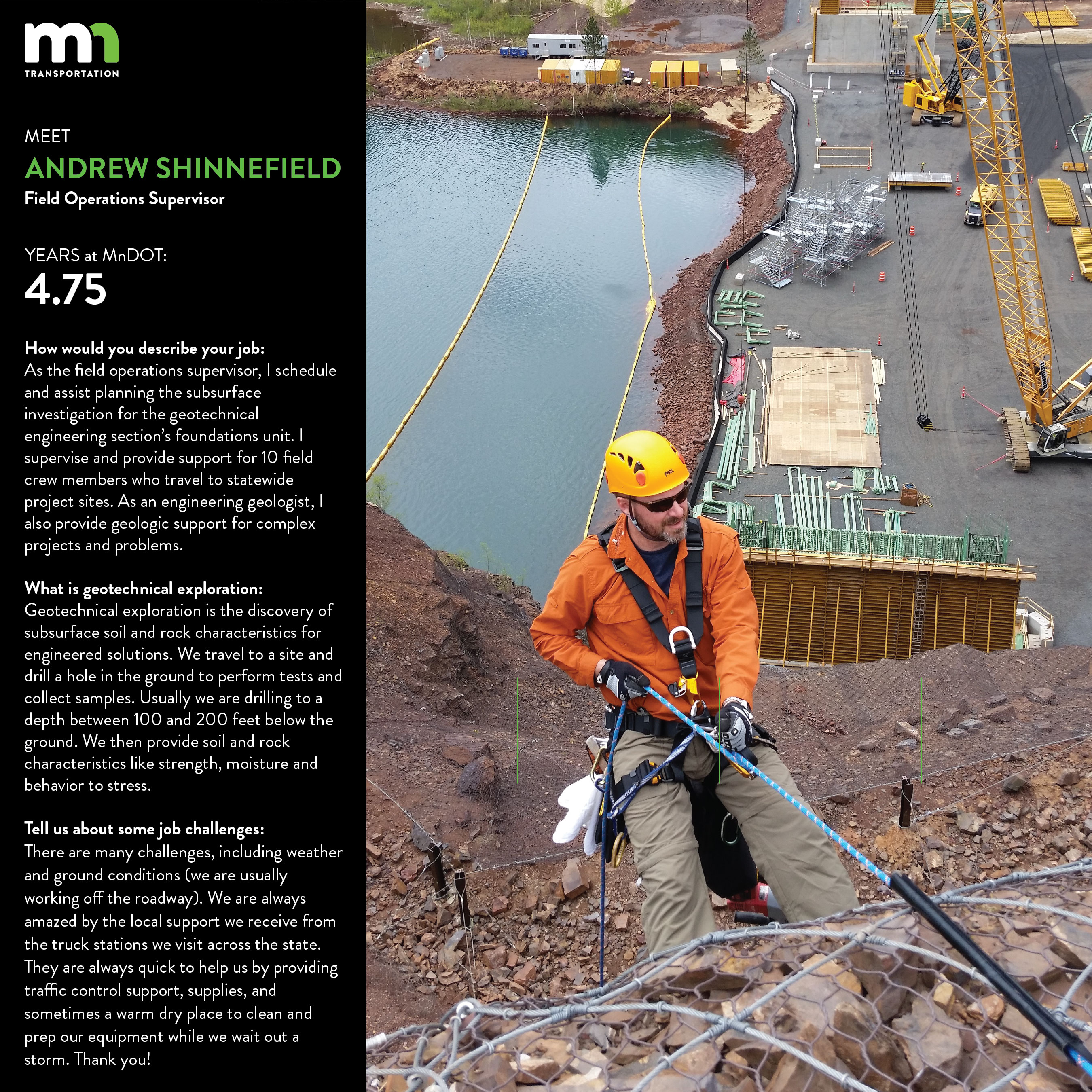
Do you or a co-worker have an interesting job to share with readers? Send us your ideas, and we’ll contact you for more information.
Recent employee profiles:
|
| |
|

|
|

|
|
| |
|



